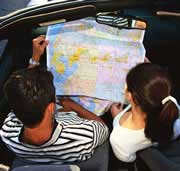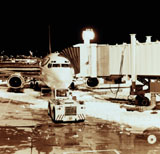Transportation and Logistics
This field deals with all spatial and time-related activities involved in bridging the gap between goods and people, including their restructuring. This begins with the supplier and follows each stage of the operational value chain to product delivery and concludes with product disposal and recycling.
innovations-report provides informative reports and articles on such topics as traffic telematics, toll collection, traffic management systems, route planning, high-speed rail (Transrapid), traffic infrastructures, air safety, transport technologies, transport logistics, production logistics and mobility.

Tackling Drunk-driving
There are no in-car methods of detecting that a driver is too drunk to drive – until now. A team at Bristol University, led by physiologist Dr Dilwyn Marple-Horvat, has found a new way of detecting whether a driver has drunk too much to be fit to be at the wheel.
To assess a driver`s fitness to drive, a new device has been created that measures the degree of co-ordination between hand and eye. It uses: an in-car eye-tracker; a system that continuously monitors steering wheel movements; and

France launches in Valenciennes a new research program on transport safety
France launches in Valenciennes a 6,4 million euro research program on transport safety. It reinforces the international position of Nord-Pas de Calais and the University of Valenciennes.
The scientific council of the New Research Action “Safety in Transport Systems”, which came together at the University of Valenciennes and Hainaut-Cambrésis on the 31st of January 2002, has just validated and launched a program composed of 7 projects stretched out until 2006. 6,4 million euros will b

Origami solves road map riddle
Match up folds to fight stubborn paper.
No road journey is complete without a wrestle with the map. Now a US computer scientist has worked out why the map usually wins.
Erik Demaine of the Massachusetts Institute of Technology in Cambridge has come up with an origami algorithm that predicts when a stubborn street plan will be re-foldable. “It’s the meeting of paper folding and computer science,” he says.
The rules governing whether a sheet of paper divided into a g

New computerised system will enable wheelchair users to easily navigate town centres
A computerised navigation system has been developed to enable wheelchair users to select the most accessible routes around a town centre. It means a journey can be planned that avoids obstacles like cobbled streets, steep areas and steps.
The work has been carried out by a team led by Professor Hugh Matthews, at University College Northampton, with funding from the Swindon based Engineering and Physical Sciences Research Council.
The ‘Wheelyroute’ system, believed to be the first

Improving mobility in the city through research
Every citizen dreams of spending less time in traffic jams, away from polluted air, while continuing to enjoy the same level of mobility and quality of life as today. On Thursday, 31 January, Commissioner for Research Philippe Busquin will participate in the conference “Towards Sustainable Urban Mobility” jointly organised by the European Commission and the European Parliament. The objective of this Conference is to present a network of ten projects in the field of land use and transport funded unde

Air traffic tussles up annoyance
Controversies over new airport runways make locals more noise-sensitive.
Public controversy surrounding the impending building of a runway may make locals much more sensitive to increased aircraft noise than planners predict. A new study warns that it could be easy to underestimate the impact of changes such as those proposed for Britain’s Heathrow Airport.
A new runway began operating at Vancouver International Airport in 1996 after highly publicized local objection to